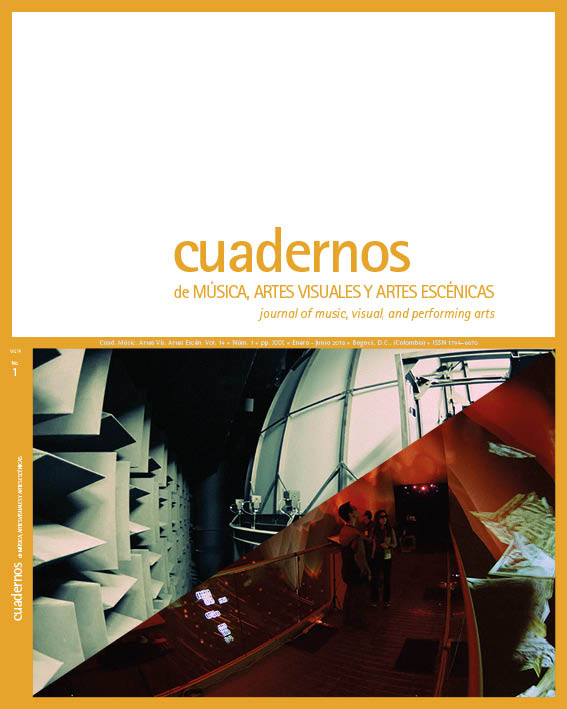Resumo
O legado de John Cage situa-se nos limites da abstração sonora a partir de uma notação musical instrucionalizada e de alto valor visual expositivo. Desde a década dos cinquenta até a publicação de Silencio (1961), as composições de tipo panteístico que aqui destacaremos responderão ao descobrimento de um novo tipo de configuração de eventos “temperados” a partir do oracular I Ching. Sua primogenitura filosófica correrá o risco de cair em uma efêmera entropia conceitual se não se leva em conta a medida do tempo para enfrentar-se ao evento, consequente da prática pedagógica profissional em nosso caso. Transitar a aleatoriedade em trabalhos como Theatre Piece (1960) sugere compartilhar um diálogo familiar de práticas sonoras nascentes para cada disciplina. A esterilidade que a obra panteística de Cage tem sofrido nos últimos trinta anos tem possibilitado desmaranhar o conflito conceitual que implica a desmaterialização do fato sonoro. A desfundamentação que aqui buscamos tem que ver com uma releitura da contemporaneidade híbrida no encontro criativo que revela uma metodologia processual e disruptiva na América Latina capaz de transformar a capacidade das estratégias institucionais transmitindo coletividades. A proposta silenciosa com a que Cage desordena a sabedoria ocidental de desesterilização permite às práticas cênicas contemporâneas sentir a necessidade de desmaterializar a natureza musical a favor de um tributo ao espaço mediador após favorecer os debates Inter geracionais em, desde, e para o sonoro.
Bois, Yve-Alain, Branden W. Joseph, Rebecca Y. Kim, Liz Kotz, James Pritchett y Julia Robinson. 2009.
La anarquía del silencio: John Cage y el arte experimental. Barcelona: Museu d’Art Contemporani.
Cage, John. 2007. Escritos al oído. Murcia: Colegio Oficial de Aparejadores y Arquitectos Técnicos.
— 2012. Silencio. Madrid: Árdora.
Claramonte, Jordi. 2016. Estética Modal. Madrid: Tecnos.
Marco, Tomás. 2003. Historia de la música occidental del siglo XX. Madrid: Alpuerto.
Pardo Salgado, Carmen, trad. 1999. “John Cage: un oído a la intemperie”. En Escritos al oído, de John Cage, 9-26. Murcia: Colegio Oficial de Aparejadores y Arquitectos Técnicos.
— 2001. La escucha oblicua: una invitación a John Cage. Valencia: Universidad Politécnica.
Ross, Alex. 2009. El ruido eterno: escuchar al siglo XX a través de su música. Barcelona: Planeta.
Trías, Eugenio. 2007. El canto de las sirenas: argumentos musicales. Barcelona: Galaxia Gutenberg.
— 2010. La imaginación sonora: argumentos musicales. Barcelona: Galaxia Gutenberg.
Esta revista científica se encuentra registrada bajo la licencia Creative Commons Reconocimiento 4.0 Internacional. Por lo tanto, esta obra se puede reproducir, distribuir y comunicar públicamente en formato digital, siempre que se reconozca el nombre de los autores y a la Pontificia Universidad Javeriana. Se permite citar, adaptar, transformar, autoarchivar, republicar y crear a partir del material, para cualquier finalidad, siempre que se reconozca adecuadamente la autoría, se proporcione un enlace a la obra original y se indique si se han realizado cambios. La Pontificia Universidad Javeriana no retiene los derechos sobre las obras publicadas y los contenidos son responsabilidad exclusiva de los autores, quienes conservan sus derechos morales, intelectuales, de privacidad y publicidad.
El aval sobre la intervención de la obra (revisión, corrección de estilo, traducción, diagramación) y su posterior divulgación se otorga mediante una licencia de uso y no a través de una cesión de derechos, lo que representa que la revista y la Pontificia Universidad Javeriana se eximen de cualquier responsabilidad que se pueda derivar de una mala práctica ética por parte de los autores. Como consecuencia de la protección brindada por la licencia de uso, la revista puede publicar retractaciones o corregir la información ya publicada. La publicación de contenidos en esta revista no representa regalías para los contribuyentes.



